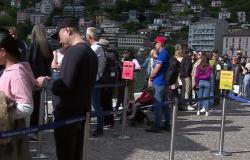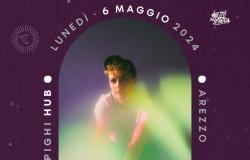25.04.2024 – 07.01 – A small church in Romanesque style, with bare stone sitting on the hill. And the Basilica of Christ the Saviorbetter known as di new Year’s Evetoday the headquarters of the Evangelical Community of the Swiss confession of Trieste. The gaze recognizes its simple medieval forms emerging from the former Jewish ghetto and looking up at the Staircase of the Gold Medals.
Yet just when the Swiss community was at the height of its power, the basilica was different from today; covered with heavy baroque superstructures, it was present in the maze of streets and squares that characterized the Zità Veciahidden from view.
Nowadays, although the Swiss people of Trieste are far from the glories of the past, the basilica continues to be a place of meeting and worship for the local community: united by faith and the awareness of a common background halfway between Trieste and Switzerland.
We talked about it with the curator of the Swiss minority, lawyer. Stefano Sabini: certainly a look at Trieste’s past, but only to relaunch the activities of the present, which are more numerous than ever.
What are the origins of the Swiss community of Trieste?
Following the granting of the free port license, Trieste became the destination for entrepreneurs coming from Switzerland; specifically from the Canton of Grisons. At the time, the Swiss from Trieste were skilled coffee makers, pastry chefs and merchants; also known for their ability to break up fights in their premises, hence the popular Trieste saying ‘God protect us from the lightning and the thunder and the punches of the Grisons‘.
From the second half of the eighteenth century until well into the nineteenth century, the Swiss presence remained important; they were prominent Swiss members of Generali, the Riunion Adriatica di Sicurtà and the Cassa di Risparmio di Trieste. Without forgetting the Swiss engineers and architects who built so much in the city.
How is the current community characterized?
It does not include large numbers, but for multiple reasons essentially linked to the city’s loss of attractiveness following the First World War. The last Swiss pastor retired in 1926; an agreement then followed with the Waldensian community for religious functions. The numbers have decreased for reasons mainly linked to the advanced age of the community members and the lack of replacement in terms of age. We are currently 30 active members with in addition some children of Protestants or Swiss who have not yet made the choice to become part of the community or not. We have recently had a reconversion of children of Swiss parents who, only as adults, chose to embrace the faith of their family and join the community through confirmation. We have grown in this sense by another 4-5 members.
Participation in the functions is good, it is around 60% of our active community, to which other members of the Protestant confessions from Trieste are added from time to time.
During the twentieth century there were no influxes or reshuffles of Swiss from Switzerland? I’m thinking for example of the diplomatic field…
It is necessary to distinguish between the Swiss religious community of Trieste, which established itself in the eighteenth century, and the Swiss community in a national sense, which is also active with its own association (Swiss Club of Trieste), but without religious value. In Trieste there are currently around four members of the community who also have Swiss citizenship. This is an identity that coincides with the Swiss religion, but not with the national identification. Swiss and Helvetians are two different elements, although in the same channel. For example, many Swiss are Catholic; think after all of the Swiss Guards of the Papal States.
What is the place of worship of the Swiss community of Trieste?
This is the Basilica of Christ the Savior, already known as San Silvestro. A rare example of Romanesque architecture in Trieste, built around the 12th century. In 1927 the basilica was the subject of a philological intervention which removed all the subsequent baroque elements, preserving only the Gothic style window on the left side and the rose window with arched rays. We Swiss began using it as a church when we won it at auction from Emperor Joseph II in 1785.
The restoration work began in 2018, continued in 2019 and the basilica was supposed to reopen in 2020, but the pause imposed by Covid-19 forced a prolonged closure. Since 2022, the basilica has been accessible again and from the beginning of 2023, thanks to the availability of pastor Alexander Erniša, one service per month is held in the basilica, allowing the structure to reopen with religious functions. From February 2023 the basilica is again a place of worship, open to the public.
Are the functions in Italian?
One of the characteristics of the Swiss people of Trieste, since the constitution from 1700 to today, has been the use of Italian for the language and documents; in fact, one of the greatest difficulties between the end of the nineteenth century and the beginning of the twentieth century was having a Swiss pastor who was willing to come to Trieste, for such a small community, to hold worship in the Italian language.
What is the social commitment of the Swiss community?
The management of the basilica has a cost and the same building in via Torrebianca 41 of the Swiss community is linked to the Fine Arts. The proceeds from the real estate assets allow us to carry out ‘surgical’ action towards people in need who we support in times of difficulty. In general we try not to waste our forces, to ensure ‘real’ help on average for two or three families. The objective is always to bring individuals out of a state of need and to become autonomous again.
In the field of philanthropy, thoughts turn to the action of the many Swiss families in the history of Trieste…
There are dynasties, with Swiss origins, which have ‘marked’ the history of Trieste. I am thinking, for example, of the Rittmeyers and the Cacciaburlos, whose mutual institutions still survive today. They were figures of patrons integrated into the social fabric of the city, whose action was ahead of their times; let’s consider the Rittmeyer institute or the campaign against illiteracy with the Protestant school.
We are still present today on the board of directors of the Rittmeyer Regional Institute for the Blind where we are a member together with the Augustan community and the Municipality of Trieste.
What are the community’s cultural activities?
The activity is aimed at opening the basilica to concerts and cultural events that allow citizens to get to know the basilica and appreciate its excellent acoustics.
Just this month, on the occasion of Tartini’s birth, an organ concert was held (the ‘Happy Birthday to Tartini’), as part of a cycle of events in honor of the great composer, financed by the European Union.
In general we want to plan something more organic for 2025, undoubtedly a monthly opportunity to meet in the basilica.
The basilica is also available for cultural events such as book presentations, being located in a key area of the city: not just a place of worship, but a ‘citizens’ building.
What is the role of music within the Swiss community?
The basilica has an organ renovated by the Zanin company. Since 1990 the ‘Organistic October’ event has been held every year where it is played by the most prominent organists in Europe.
There is also an agreement with the Tartini Conservatory, especially thanks to Maestro Tomadin, so that the students of the Conservatory can come and practice in the basilica, using the organ free of charge.
What is the archival heritage of the Swiss community?
The building next to the Basilica houses the secretariat, the community areas, a meeting room and finally the library. It is an important collection of five thousand volumes that extends from the mid-1500s to the present day, defined since 1991 as ‘Library specializing in the Reformation, Counter-Reformation and Biblical Disciplines’. Nowadays it is open for loans and consultations on Tuesdays and Fridays from 10 to 12 and is fully included in the Julian Library System.
The archive, however, has had a more troubled life, because in the 1950s it was decided to transfer much of the material to Bern, to the federal archives, and despite our requests for restitution we were unable to get the papers back.
They only returned the microfilms that have now been digitized; although the quality of the source material was somewhat low.
250 years of history will soon occur, so it would be necessary for the digitized material to be made accessible.
What is the presence of Swiss people in Italy and in the neighboring states of Friuli Venezia Giulia?
In Italy, Trieste, Milan and Florence remain. Up until seven or eight years ago there was also a Swiss community in Genoa. Milan is the only one which, being an economic capital, attracts Swiss of the Swiss religion who go there for work.
However, there are no Swiss in Slovenia, but there are still Swiss communities today in Austria and in Eastern European countries.
What are the community’s future plans?
Without a doubt the opening of the basilica – and therefore of the community – to events of a literary, artistic and musical nature; the complete digitization of the archive and finally the social commitment towards those most in need.
[La Comunità Evangelica di confessione Elvetica ha sede in Piazzetta San Silvestro 1 ed è contattabile al numero di telefono 040 632770 e alla mail [email protected]
The Library is open to the public for consultations and loans on Tuesdays and Fridays from 10 to 12.]
[z.s.]






